2018 MERCEDES-BENZ S-CLASS SEDAN ignition
[x] Cancel search: ignitionPage 399 of 562

#Pushthe plug of hose 5into flange 6of
tire sealant bottle 1until the plug engages.
#Place tire sealant bottle 1head down wards
into recess 2ofthe tire inflation compres‐
sor.
#Re mo vethe cap from valve 7 onthe defec‐
tive tire.
#Scr ew filling hose 8onto valve 7.
#Insert plug 4into a 12‑V‑sock etinyour
ve hicle.
#Switch on the ignition.
#Press on and off switch 3onthe tire infla‐
tion compressor.
The tire inflation compressor is switched on.
The tire is inflated. Fir st, tire sealant is pum‐
ped into the tire. The pressure may brief ly
ri se toappr oximately 500 kPa (5 bar/73 psi).
Do not switch off the tire inflation compres‐
sor du ring this phase.
#Let the tire inflation compressor runfo r a
maximum of eight minutes.
The tire should then ha veattained a tire
pressure of at least 180 kPa (1.8 bar/26 psi).
If tire sealant leaks out, make sureyou clean the
af fected area as quickly as possible. It is prefera‐
ble touse clean water.
If yo uge t tire sealant on your clo thing, ha veit
cleaned as soon as possible with per chloroe thy‐
lene.
If atire pressure of 180 kPa (1.8 bar/26 psi)
has not been attained af ter eight minutes:
#Switch off the tire inflation compressor.
#Un scr ew thefilling hose from theva lve of the
defective tire.
Please no tethat tire sealant may leak out when
unscr ewing thefilling hose.
#Ve ry slowly drive forw ards or reve rse appr ox‐
imately 33 ft(10 m).
#Pump up the tire again.
Af ter a maximum of eight minutes the tire
pressure must be at least 180 kPa (1.8 bar/
26 psi).
& WARNING Risk of accident due tothe
specified tire pressure not being reached
If th e specified tire pressure is not reached
af te rth e specified time, the tire is too badly
damaged. The tire sealant cannot repair the
tire in this ins tance.
Dama ged tires and a tire pressure that is too
low can significantly impair braking and han‐
dling characteristics.
#Do not continue driving.
#Consult a qualified specialist workshop.
Breakdown assis tance 397
Page 405 of 562
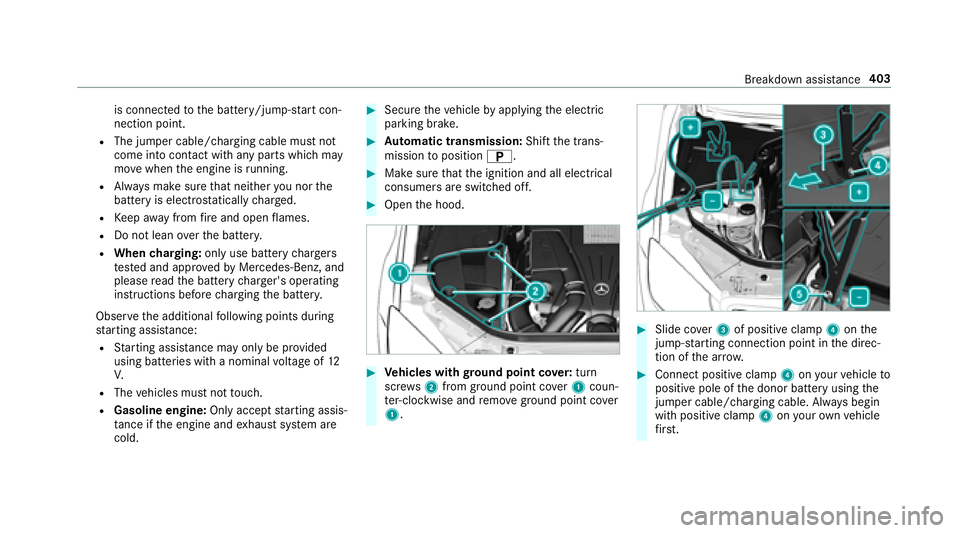
is connectedto the battery/jump-s tart con‐
nection point.
RThe jumper cable/charg ing cable must not
come into con tact wi thany parts which may
mo vewhen the engine is running.
RAlw ays make sure that nei ther you nor the
battery is elect rostatically charge d.
RKe ep away from fire and open flames.
RDo not lean overth e batter y.
RWhencharging: only use battery charge rs
te sted and appr ovedby Mercedes-Benz, and
please read the battery charge r's operating
instructions before charging the batter y.
Obser vethe additional following points during
st arting assis tance:
RSt arting assis tance may only be pr ovided
using batteries with a nominal voltage of 12
V.
RThe vehicles must not touch.
RGa soline engine: Onlyaccept starting assis‐
ta nce if the engine and exhaust sy stem are
cold.
#Secure theve hicle byapplying the electric
parking brake.
#Au tomatic transmission: Shiftthe trans‐
mission toposition B.
#Make sure that the ignition and all electrical
consumers are switched off.
#Open the hood.
#Ve hicles with ground point co ver:tur n
sc rews 2 from ground point co ver1 coun‐
te r-clockwise and remo veground point co ver
1.
#Slide co ver3 of positive clamp 4onthe
jump-s tarting connection point in the direc‐
tion of the ar row.
#Connect positive clamp 4onyour vehicle to
positive pole of the donor battery using the
jumper cable/charging cable. Alw ays begin
with positive clamp 4onyour ow nve hicle
fi rs t.
Breakdown assist ance403
Page 408 of 562

#Atowing speed of 30 mph (50 km/h)
must not be exceeded.
#Atowing dis tance of 30 miles (50 km)
must not be exceeded.
&
WARNING Risk of accident when towing
a ve hicle which is too heavy
If th eve hicle being tow- star ted or towe d
aw ay is heavier than the permissible gross
mass of your vehicle, thefo llowing situations
can occur:
RThe towing eye may become de tach ed.
RThe vehicle/trailer combination may
swer veoreve nov erturn.
#If ano ther vehicle is tow- star ted or
to we daw ay, its weight must not exceed
th e permissible gross mass of your ow n
ve hicle.
If a vehicle must be tow- star ted or towe daw ay,
its weight must not exceed the permissible gross
mass of theto wing vehicle.
#Information on the permissible gross mass of
th eve hicle can be found on theve hicle iden‐
tification plate (
→page 445).
#Do not open the driver's door or front
passenger door, otherwise the automatic
transmission automatically shifts toposition
j.
#Ins tallth eto wing eye (→page 409).
#Attach theto w bar.
* NO
TEDama gedue toincor rect connec‐
tion
#Only connect theto w rope or tow bar to
th eto wing eyes.
#Deactivate the automatic locking mechanism
(→page 64).
#Do not activate the HOLD function.
#Deactivate Active Brake Assi st(→page 196).
#Shift the automatic transmission toposition
i.
#Re lease the electric parking brake.
&
WARNING Risk of accident due tolimi‐
te d saf ety-re lated functions during the
to wing process
Saf ety-re lated functions are limited or no lon‐
ge rav ailable in thefo llowing situations:
Rth e ignition is switched off.
Rthe brake sy stem or po werst eering sys‐
te m is malfunctioning.
Rth e energy supply or the on-board electri‐
cal sy stem is malfunctioning.
When your vehicle is then towe daw ay, signif‐
icantly more ef fort may be requ ired tosteer
and brake than is no rmally requ ired.
#Use a tow bar.
#Make sure that thesteering wheel can
mo vefreely, before towing theve hicle
aw ay.
406
Breakdown assis tance
Page 412 of 562

Electrical fuses
Notes on electrical fuses
&
WARNING Risk of accident and injury
due to ov erloaded lines
If yo u man ipulate orbridg e afaulty fuse or if
yo ure place it with a fuse with a higher
amperage, the electric line could be overloa‐
ded.
This could result in a fire .
#Alw aysre place faulty fuses with speci‐
fi ed new fuses conta iningthe cor rect
amperage.
* NO
TEDama gecaused byincor rect fuses
Incor rect fuses may cause damage toelectri‐
cal components or sy stems.
#Only use Mercedes-Benz appr oved
fuses with the cor rect fuse rating.
Blown fuses must bereplaced with fuses of the
same rating, which you can recognize bythe
color and fuse rating. The fuse ratings are li sted in
the fuse assignment diagram. The fuse assign‐
ment diagram is in theve hicle document wallet.
* NO
TEDama geor malfunctions caused
by moisture
Moisture may cause dama getothe electrical
sy stem or cause it tomalfunction.
#When the fuse box is open, make sure
th at no moisture can enter the fuse
box.
#When closing the fuse box, make sure
th at the seal of the lid is positioned cor‐
re ctly on the fuse box.
Ifth e newly inser ted fuse also blo ws, ha vethe
cause traced and rectified at a qualified special‐
ist workshop, e.g. an authorized Mercedes-Benz
Center.
Ensure thefo llowing before replacing a fuse:
RThe vehicle is secured against rolling away.
RAll electrical consumers are switched off.
RThe ignition is switched off. The electrical fuses are located in
various fuse
bo xes:
RFu se box in the engine compartment on the
driver's side (→page 410)
RFu se box on the driver's side of the dash‐
board (→page 412)
RFu se box in the front-passen gerfo ot we ll
(→page 412)
RFu se box in the trunk on theright-hand side
of theve hicle, when vie wed in the direction
of tra vel (
→page 412)
Fu se box in the engine compa rtment
Requ irements:RObser vethe no tes on electrical fuses
(→page 410).
Ha ve thefo llowing readily available:
RA dry clo th
RA screwdriver
410
Breakdown assis tance
Page 413 of 562
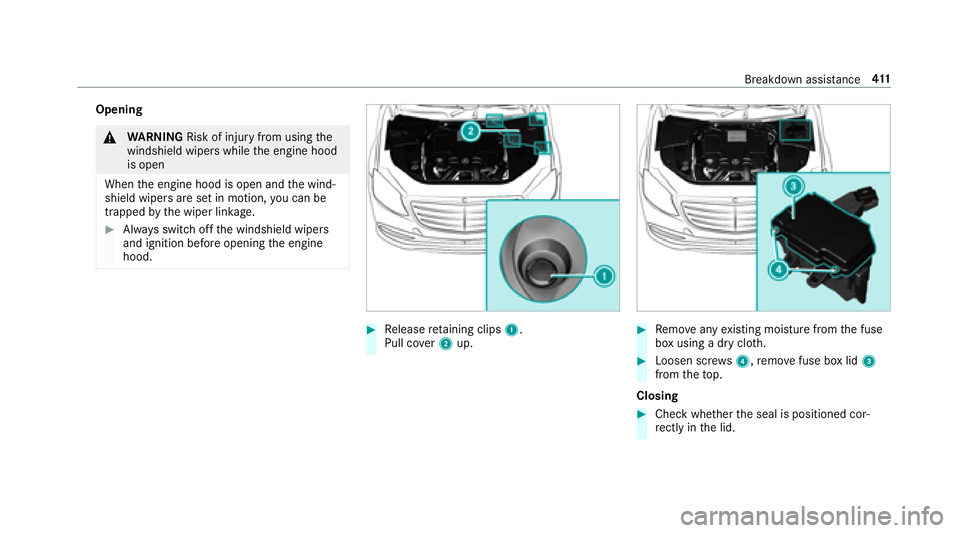
Opening
&WARNING Risk of injury from usingthe
windshield wipers while the engine hood
is open
When the engine hood is open and the wind‐
shield wipers are set in motion, you can be
trapped bythe wiper linkage.
#Alw ays switch off the windshield wipers
and ignition before opening the engine
hood.
#Re lease retaining clips 1.
Pull co ver2 up.#Remo veany existing moisture from the fuse
box using a dry clo th.
#Loosen scr ews4, remo vefuse box lid 3
from theto p.
Closing
#Check whe ther the seal is positioned cor‐
re ctly in the lid.
Breakdown assis tance 41
1
Page 421 of 562
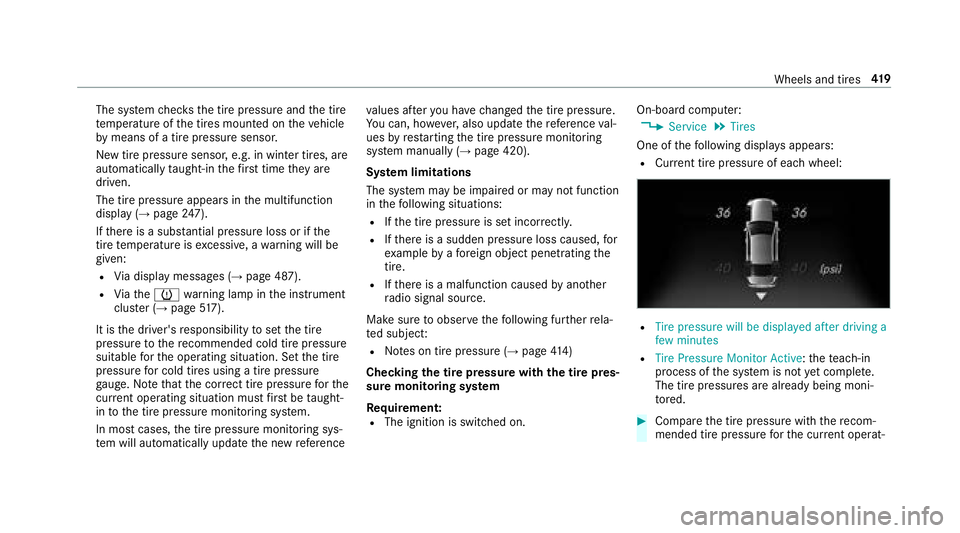
The system checks the tire pressure and the tire
te mp erature of the tires mounted on theve hicle
by means of a tire pressure sensor.
New tire pressure sensor, e.g. in winter tires, are
automatically taught-in thefirs t time they are
driven.
The tire pressure appears in the multifunction
display (
→page 247).
If th ere is a subs tantial pressure loss or if the
tire temp erature is excessive, a warning will be
given:
RVi a display messages (→page 487).
RViath eh warning lamp in the instrument
clus ter (→page 517).
It is the driver's responsibility toset the tire
pressure tothere commended cold tire pressure
suitable forth e operating situation. Set the tire
pressure for cold tires using a tire pressure
ga uge. No tethat the cor rect tire pressure forth e
cur rent operating situation must firs t be taught-
in to the tire pressure monitoring sy stem.
In most cases, the tire pressure monitoring sys‐
te m will auto matically update the new refere nce va
lues af teryo u ha vechanged the tire pressure.
Yo u can, ho wever,also update there fere nce val‐
ues byrestarting the tire pressure monitoring
sy stem manually (
→page 420).
Sy stem limitations
The sy stem may be impaired or may not function
in thefo llowing situations:
RIf th e tire pressure is set incor rectly.
RIfth ere is a sudden pressure loss caused, for
ex ample byafo re ign object penetrating the
tire.
RIf th ere is a malfunction caused byano ther
ra dio signal source.
Make sure toobser vethefo llowing fur ther rela‐
te d subjec t:
RNotes on tire pressure (→page 414)
Checking the tire pressure with the tire pres‐
sure moni toring sy stem
Requ irement:
RThe ignition is switched on. On-board computer:
,�6�H�U�Y�L�F�H.�7�L�U�H�V
One of thefo llowing displa ysappears:
RCur rent tire pressure of ea chwheel:
R�7�L�U�H �S�U�H�V�V�X�U�H �Z�L�O�O �E�H �G�L�V�S�O�D�\�H�G �D�I�W�H�U �G�U�L�Y�L�Q�J �D
�I�H�Z �P�L�Q�X�W�H�V
R�7�L�U�H �3�U�H�V�V�X�U�H �0�R�Q�L�W�R�U �$�F�W�L�Y�H: thete ach-in
process of the sy stem is not yet comple te.
The tire pressures are already being moni‐
to re d.
#Compare the tire pressure with there com‐
mended tire pressure forth e cur rent operat‐
Wheels and tires 41
9
Page 450 of 562
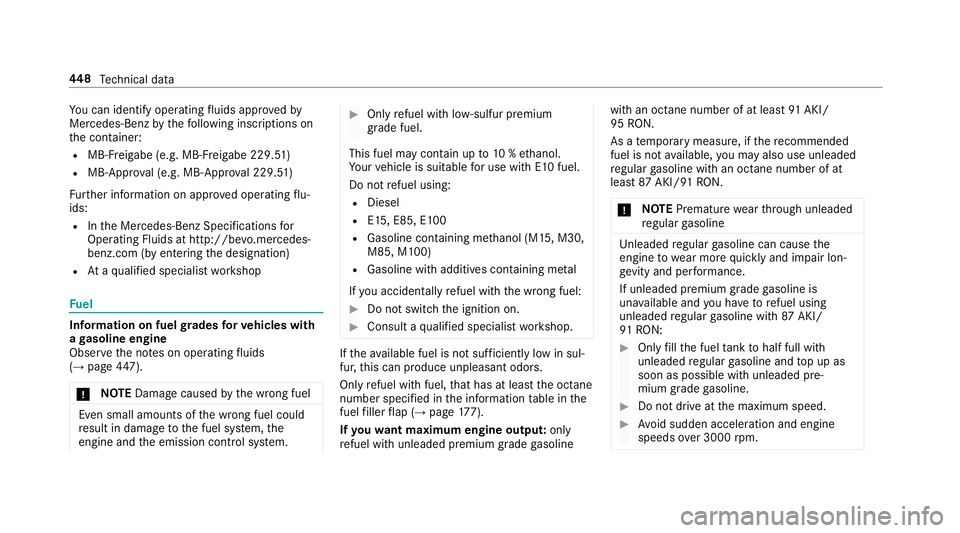
You can identify operating fluids appr ovedby
Mercedes-Benz bythefo llowing insc ript ions on
th e conta iner:
RMB-Freigabe (e.g. MB-Fr eigabe 229.51)
RMB-Approval (e.g. MB-App rova l 229.51)
Fu rther information on appr oved operating flu‐
ids:
RIn the Mercedes-Benz Specifications for
Operating Fluids at http://be vo.mercedes-
benz.com (byen tering the designation)
RAt aqu alified specialist workshop
Fu el
Information on fuel grades forve hicles with
a ga soline engine
Obser vethe no tes on operating fluids
(
→page 447).
* NO
TEDama gecaused bythe wrong fuel
Even small amounts of the wrong fuel could
re sult in damage tothe fuel sy stem, the
engine and the emission control sy stem.
#Only refuel with lo w-sulfur premium
grade fuel.
This fuel may contain up to10 %ethanol.
Yo ur vehicle is suitable for use with E10 fuel.
Do not refuel using:
RDiesel
RE15, E85, E100
RGasoline containing me thanol (M15, M30,
M85, M100)
RGasoline with additives con taining me tal
If yo u accidenta llyrefuel with the wrong fuel:
#Do not switch the ignition on.
#Consult a qualified specialist workshop.
Ifth eav ailable fuel is not suf ficiently low in sul‐
fur, this can produce unpleasant odors.
Only refuel with fuel, that has at least the octane
number specified in the information table in the
fuel filler flap (
→page 177).
If yo uwa nt maximum engine output: only
re fuel with unleaded premium grade gasoline with an octane number of at least
91AKI/
95 RON.
As a temp orary measure, if there commended
fuel is not available, you may also use unleaded
re gular gasoline with an octane number of at
least 87AKI/91 RON.
* NO
TEPremature wearthro ugh unleaded
re gular gasoline
Unleaded regular gasoline can cause the
engine towe ar more quickly and impair lon‐
ge vity and per form ance.
If unleaded premium grade gasoline is
una vailable and you ha vetorefuel using
unleaded regular gasoline with 87AKI/
91 RON:
#Only fill th e fuel tank tohalf full with
unleaded regular gasoline and top up as
soon as possible with unleaded pre‐
mium grade gasoline.
#Do not drive at the maximum speed.
#Av oid sudden acceleration and engine
speeds over 3000 rpm.
44 8
Tech nical da ta
Page 465 of 562
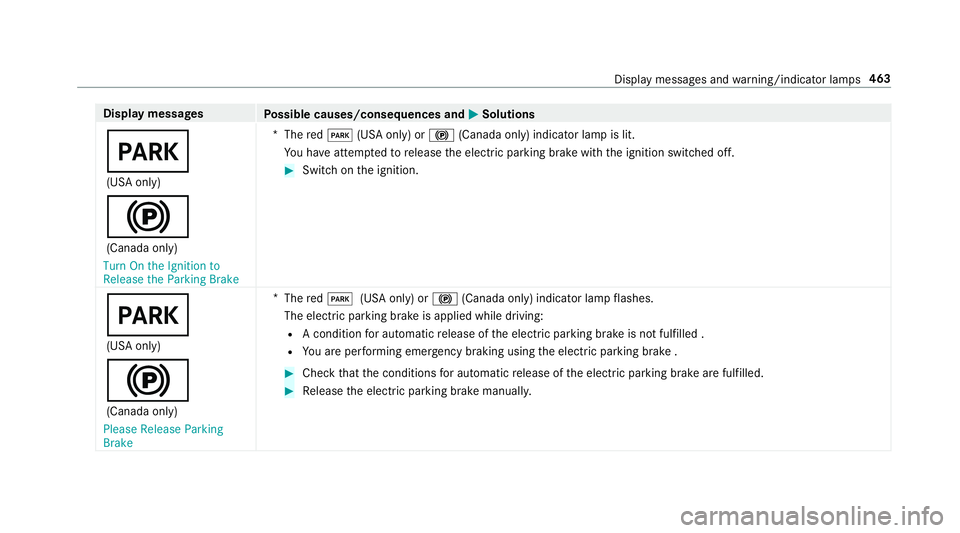
Displaymessages
Possible causes/consequences and MSolutions
F
(USA only)
!
(Canada only)
�7�X�U�Q �2�Q �W�K�H �,�J�Q�L�W�L�R�Q �W�R
�5�H�O�H�D�V�H �W�K�H �3�D�U�N�L�Q�J �%�U�D�N�H *
The redF (USA only) or !(Canada only) indicator lamp is lit.
Yo u ha veattem ptedto release the electric parking brake with the ignition switched off.
#Switch on the ignition.
F
(USA only)
!
(Canada only)
�3�O�H�D�V�H �5�H�O�H�D�V�H �3�D�U�N�L�Q�J
�%�U�D�N�H *
The redF (USA only) or !(Canada only) indicator lamp flashes.
The electric parking brake is applied while driving:
RA condition for au tomatic release of the electric parking brake is not fulfilled .
RYo u are per form ing emer gency braking using the electric parking brake .
#Check that the conditions for au tomatic release of the electric parking brake are fulfilled.
#Re lease the electric parking brake manually.
Display messages and warning/indicator lamps 463